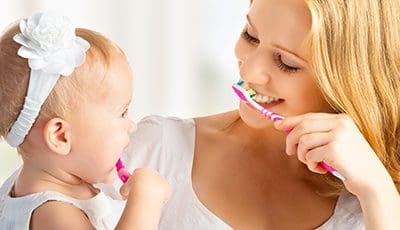Good Oral Health for Babies
Good Oral Health for Babies
Baby teeth, also known as primary teeth, are just as important as permanent teeth. The primary teeth help your child speak and chew. They also act as placeholders for the permanent teeth. Good oral health is important and should start as soon as solid food is introduced. Here are some basics:

Baby oral health (pre teeth)
- Before a tooth breaks the surface make sure to wipe your baby’s gums with a finger brush, washcloth, or piece of gauze.
- Baby teeth generally arrive between 3 and 12 months. A newly erupting tooth can cause some discoloration in the gum where the tooth is going to pop up. Before a tooth completely breaks the surface, there may be a small opening where bacteria can begin to grow and cause a cavity. It is especially important that you continue to wipe your baby’s gums with a finger brush/washcloth/gauze during this time to prevent a cavity before the tooth appears.
The first tooth
- Tooth decay can occur as soon as your child’s first tooth arrives so it is important that you begin to brush your child’s teeth twice per day.
- To brush the tooth/teeth you can use a wet washcloth or gauze to clean your baby’s teeth and gums. Start using a baby toothbrush and a small dab of fluoride free toothpaste when your baby is between 1 year old and 18 months.
- Schedule your first child’s first dental visit within 6 months after the baby’s first tooth appears.
You scheduled you child’s first dental visit by their first birthday, now what?
Packing for the visit
- To help your child know that the dental office is a safe and comfortable place it is important to bring some items that will make it feel more like home. A favorite toy or blanket, snack, and an extra diaper just in case.
- Fill out and bring any forms needed by the dentist.
What to expect at the office
- The dentist or hygienist will review your child’s overall health, focusing on oral health. This includes your child’s development, bite, soft tissue (gums and cheeks), teething, oral habits such as sucking, diet and hygiene practices that could affect the risk of cavities.
- The dentist will preform a short exam, generally with the child on your lap, and his or her head in the dentists lap. This way both of you can see clearly into your child’s mouth and your child can look up at you. The dentist will check all of your child’s existing teeth for decay, examine the gums, jaw and oral tissues for any potential issues, and examine your child’s bite.
- The dentist will brief you on proper nutrition, good oral hygiene practices for your child’s teeth and gums, cavity prevention, developmental milestones, teething, fluoride needs, as well as give you the opportunity to ask any questions.
After the visit
- Most dentists like to schedule the next visit within 6 months to track the development of teeth and build up the child’s comfort and confidence levels.
Start using a child’s soft-bristle toothbrush and skip the toothpaste or use a fluoride free toddle brand. Make sure to let your child help with the brushing!